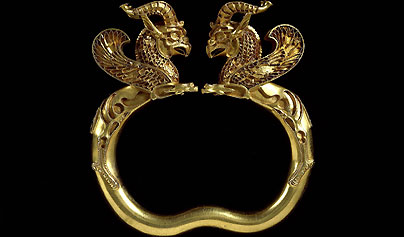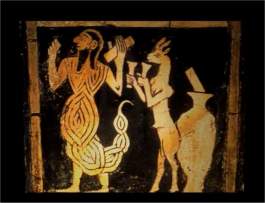
Latest archeological excavations in Jiroft, known as the hidden paradise of world archeologists, resulted in the discovery of a bronze statue depicting the head of goat which dates back to the third millennium BC. This statue was found in the historical cemetery of Jirof where recent excavations in the lower layers of this cemetery revealed that the history of the Halil Rud region dates back to the fourth millennium BC, a time that goes well beyond the age of civilization in Mesopotamia
"One of the reasons the archeologists and historians give for Mesopotamia to be the cradle of civilization is that the most ancient historical evidence and relics which have been discovered in Jiroft so far date back to the third millennium BC or nearer, and therefore they argue that this region could not have been the place where civilization began. However, some cultural evidence and ancient artifacts belonging to the fourth millennium BC were traced while digging a trench beneath the Matot Abad cemetery which gave proof to the fact that the history of this region goes back to the sixth millennium BC. Aside from these ancient articles found so far, archeologists were able to unearth a bronze statue of the head of a goat from one of the graves of Jiroft cemetery which raised new questions about the history of this region and whether or not the civilization that lived here is older than that of Mesopotamia," said Yousof Majidzadeh, head of excavation team in Jiroft.
"Two different kinds of clays were discovered in this cemetery, some belong to third millennium BC while the others go back to the fourth millennium BC. It was supposed that this area was a cemetery in both periods, but the trenches dug under the cemetery indicate that the region was a residential area during the sixth millennium BC. After this area was covered by different sediments and layers little by little over the period of 1000 years, the cemetery was established on the remains of the previous settlement area. The team of archeologists who are working in this area at the present is determined to continue the excavations to study more about the lower layers," added Majidzadeh.
According to Majidzadeh, geophysical operations by French experts in the region indicate the existence at least 10 historical and archaeological periods in the region belonging to different civilizations who lived in this area during different periods of time in history. According to the French experts who studied this area, the evidence remained from these civilizations may be traced up to 11 meters under the ground.
"What is obvious is that the evidence of Tal-i-Iblis culture in Bardsir can be traced in all parts of the region. Tal-i-Iblis culture, known as Ali Abad period (fourth millennium BC) was revealed by Joseph R. Caldwell, American archaeologist," said Majidzadeh.
Plunder of Matot Abad cemetery by the smugglers, which caused an unbelievable disaster in the history of archaeology, attracted the attention of public opinion to this region. Only from one of the cemeteries 30 stone dishes were plundered. Some metal and clay dishes as well as some gold articles were plundered by smugglers as well.
The excavations in the lower layers of Jiroft's cemetery indicate that the history this region goes back to the fourth millennium BC. This further provided the proof to the claim that Jiroft was the cradle of civilization long before civilization first appeared in Mesopotamia, although this claim has not yet been approved by world organizations.
Analytical studies on relics found in Jirof in a research center in the United States indicate that the discovered materials in this region date back to the third millennium BC. Considering an inscription found earlier in the region, archeologists believe that the writing language of Jiroft is more ancient than that of Mesopotamia, and that the script language was spread to Mesopotamia from this region.
"One of the reasons the archeologists and historians give for Mesopotamia to be the cradle of civilization is that the most ancient historical evidence and relics which have been discovered in Jiroft so far date back to the third millennium BC or nearer, and therefore they argue that this region could not have been the place where civilization began. However, some cultural evidence and ancient artifacts belonging to the fourth millennium BC were traced while digging a trench beneath the Matot Abad cemetery which gave proof to the fact that the history of this region goes back to the sixth millennium BC. Aside from these ancient articles found so far, archeologists were able to unearth a bronze statue of the head of a goat from one of the graves of Jiroft cemetery which raised new questions about the history of this region and whether or not the civilization that lived here is older than that of Mesopotamia," said Yousof Majidzadeh, head of excavation team in Jiroft.
"Two different kinds of clays were discovered in this cemetery, some belong to third millennium BC while the others go back to the fourth millennium BC. It was supposed that this area was a cemetery in both periods, but the trenches dug under the cemetery indicate that the region was a residential area during the sixth millennium BC. After this area was covered by different sediments and layers little by little over the period of 1000 years, the cemetery was established on the remains of the previous settlement area. The team of archeologists who are working in this area at the present is determined to continue the excavations to study more about the lower layers," added Majidzadeh.
According to Majidzadeh, geophysical operations by French experts in the region indicate the existence at least 10 historical and archaeological periods in the region belonging to different civilizations who lived in this area during different periods of time in history. According to the French experts who studied this area, the evidence remained from these civilizations may be traced up to 11 meters under the ground.
"What is obvious is that the evidence of Tal-i-Iblis culture in Bardsir can be traced in all parts of the region. Tal-i-Iblis culture, known as Ali Abad period (fourth millennium BC) was revealed by Joseph R. Caldwell, American archaeologist," said Majidzadeh.
Plunder of Matot Abad cemetery by the smugglers, which caused an unbelievable disaster in the history of archaeology, attracted the attention of public opinion to this region. Only from one of the cemeteries 30 stone dishes were plundered. Some metal and clay dishes as well as some gold articles were plundered by smugglers as well.
The excavations in the lower layers of Jiroft's cemetery indicate that the history this region goes back to the fourth millennium BC. This further provided the proof to the claim that Jiroft was the cradle of civilization long before civilization first appeared in Mesopotamia, although this claim has not yet been approved by world organizations.
Analytical studies on relics found in Jirof in a research center in the United States indicate that the discovered materials in this region date back to the third millennium BC. Considering an inscription found earlier in the region, archeologists believe that the writing language of Jiroft is more ancient than that of Mesopotamia, and that the script language was spread to Mesopotamia from this region.
click to read more about first civilization (Jiroft)
click to see some objects from Jiroft (Aratta)
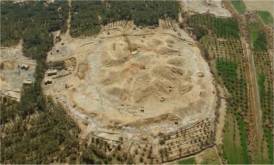 Older than Sumer ziggurat (2300 BC)
Older than Sumer ziggurat (2300 BC)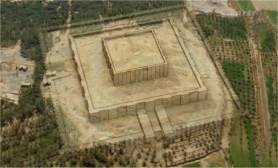
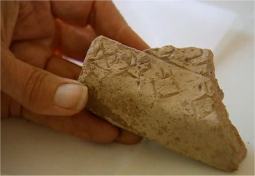
THE FIRST EVIDENCE OF WRITTING OLDER THAN SUMMERIAN
Some Jiroft Objects dates back to 3000BC
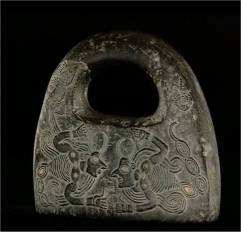

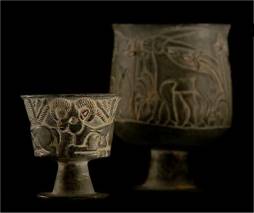

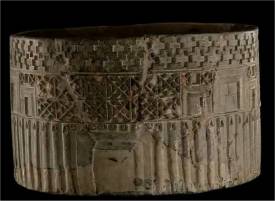


HOME BACK
